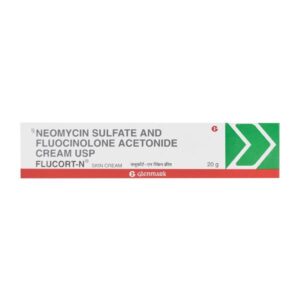FLUOCINOLONE + NEOMYCIN
Fluocinolone: Fluocinolone is a corticosteroid medication that is used to treat various skin conditions such as eczema, psoriasis, allergic reactions, and dermatitis. It works by reducing inflammation, itching, and redness associated with these conditions.
The drug is available in various forms including creams, ointments, and scalp oil, allowing for easy application to the affected areas. It should typically be applied thinly to the affected area once or twice a day, as directed by a healthcare professional.
As a corticosteroid, fluocinolone suppresses the immune system’s inflammatory response, thereby reducing the symptoms of inflammation. It specifically inhibits the production of certain chemical substances in the body that play a role in the inflammatory process.
Common side effects of fluocinolone may include skin irritation, burning, itching, dryness, or redness at the application site. Long-term use of corticosteroids can lead to skin thinning, stretch marks, and increased susceptibility to infections. It is important to follow the prescribed dosage and duration of treatment to minimize the risk of these side effects.
Some individuals may be more prone to experiencing side effects, such as children, the elderly, or those who use the medication over a large area of the body. It is recommended to discuss any concerns or potential side effects with a healthcare provider before using fluocinolone.
Neomycin: Neomycin is an antibiotic drug that is used to treat various infections. It belongs to the class of drugs known as aminoglycosides and is commonly used topically or orally to treat intestinal infections, as well as in combination with other antibiotics to prevent infection in certain surgical procedures.
Neomycin works by inhibiting the synthesis of protein in bacteria, leading to their death. It achieves this by binding to the bacterial ribosomal subunit, preventing the formation of functional proteins. This mechanism of action makes it effective against a wide range of bacteria.
When administered orally, neomycin is poorly absorbed into the bloodstream and primarily acts locally in the gut. The typical adult dose for oral neomycin ranges from 1-2 grams divided into 3-4 doses per day. For topical use, it is applied to the affected area in the form of creams or ointments.
While neomycin is generally effective, it is known to cause some side effects. Common side effects include nausea, vomiting, diarrhea, and stomach cramps when taken orally. It may also cause skin irritation or allergic reactions when used topically. In rare cases, neomycin can lead to more serious side effects such as kidney damage or hearing loss, particularly if used for prolonged periods or at high doses.
It is important to note that neomycin can have interactions with other medications, such as certain diuretics or muscle relaxants, and may reduce their efficacy. Additionally, individuals with kidney dysfunction or hearing impairment should exercise caution when using neomycin.
Overall, neomycin is a potent antibiotic drug with a broad-spectrum of activity. Its proper use should be guided by a healthcare professional to minimize the risk of side effects and maximize its effectiveness.

